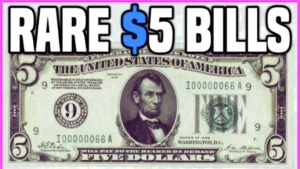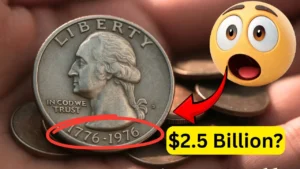Have you ever checked your pocket change for rare coins? Certain dimes and Bicentennial quarters from the 1970s could be worth a fortune, Discover Hidden Gems with some rumored to fetch up to $79 million each! These coins, minted to celebrate America’s 200th anniversary, are sparking excitement among collectors and everyday people alike. In this guide, we’ll break down what makes these coins so valuable, how to spot them, and why they’re creating such a buzz.
Why Are These Coins So Special?
A Piece of American History
In 1975 and 1976, the U.S. Mint released special quarters to mark the 200th anniversary of the Declaration of Independence. Known as Bicentennial quarters, these coins feature a unique design with a Colonial drummer on the back and a dual date (1776-1976) on the front. While most of these quarters are worth just 25 cents, rare versions with unique features can be incredibly valuable.
Dimes from the same era, especially those with rare minting errors or limited production, are also highly sought after. These coins aren’t just money—they’re tiny pieces of history that tell a story of America’s past.
The Hype Around High Values
Recent online buzz has claimed that some of these coins could be worth millions. While such high valuations are rare and often exaggerated, certain dimes and quarters have sold for impressive amounts due to their rarity, condition, or unique errors. This has led collectors and curious folks to rummage through old coin jars, hoping to strike it rich.
What Makes a Coin Valuable?

Rarity and Minting Errors
The value of a coin depends on a few key factors:
- Low Mintage: Coins produced in small quantities are harder to find and often worth more.
- Minting Errors: Mistakes during production, like a quarter struck on a dime’s blank, can make a coin extremely rare.
- Condition: Coins in pristine, uncirculated condition are more valuable than worn ones.
- Historical Significance: Bicentennial quarters, tied to a major U.S. milestone, hold special appeal for collectors.
Specific Coins to Look For
Here’s a table highlighting some rare dimes and Bicentennial quarters that could be worth big money:
| Coin Type | Year | Key Feature | Potential Value |
| 1969-S Roosevelt Dime | 1969 | Proof with no mint mark | Up to $1 million |
| 1970 No-S Roosevelt Dime | 1970 | Missing “S” mint mark | Up to $500,000 |
| 1975 No-S Roosevelt Dime | 1975 | Missing “S” mint mark | Up to $2 million |
| 1976 Bicentennial Quarter | 1976 | Struck on a dime planchet | Up to $12,000 |
| 1976-S Silver Bicentennial | 1976 | Silver-clad, MS69 grade | Up to $19,200 |
Note: These values are based on auction records and professional grading services like PCGS and NGC. Always verify with a professional before selling.
How to Identify Valuable Coins
Check the Mint Mark
The mint mark, a small letter on the coin, shows where it was made:
- D: Denver
- S: San Francisco
- No mark: Philadelphia
Rare dimes, like the 1975 No-S Roosevelt Dime, lack the “S” mint mark, making them highly valuable. For Bicentennial quarters, look for the “S” mark on silver-clad versions or errors like a quarter struck on a dime’s smaller blank.
Examine the Condition
Coins are graded on a scale from 1 to 70, with 70 being perfect. Higher grades, like MS67 or MS68, mean the coin is in excellent condition and worth more. Check for scratches, wear, or discoloration—pristine coins fetch the highest prices.
Look for Errors
Minting errors, like a quarter struck on a dime’s metal or a missing mint mark, can skyrocket a coin’s value. Use a magnifying glass to inspect details closely.
Where to Find These Coins
Check Your Change
You might find these coins in everyday places:
- Pocket Change: Always inspect coins before spending them.
- Old Coin Jars: Family heirlooms or forgotten collections could hold treasures.
- Estate Sales or Flea Markets: Older coins often surface at these events.
Work with Professionals
To confirm a coin’s value, consult a reputable coin dealer or grading service like PCGS or NGC. They can authenticate and appraise your coin, ensuring you get a fair price if you decide to sell.
Tips for Selling Valuable Coins
- Get It Graded: Professional grading adds credibility and can increase value.
- Research Auction Houses: Reputable auction houses like Heritage Auctions specialize in rare coins.
- Avoid Cleaning: Cleaning coins can damage them and lower their value.
- Stay Realistic: While million-dollar claims grab headlines, most valuable coins sell for thousands, not millions.
Why the $79 Million Claim May Be Misleading
The idea that a single dime or quarter is worth $79 million often comes from viral online stories rather than actual auction records. While some dimes, like the 1894-S Barber Dime, have sold for millions, Bicentennial quarters rarely reach such astronomical values. For example, a 1976 quarter struck on a dime planchet sold for $12,000 in 2021, far from $79 million. Always verify claims with trusted sources to avoid disappointment.
Conclusion
The hunt for rare dimes and Bicentennial quarters is an exciting adventure that combines history, treasure hunting, and the chance for a big payout. While the $79 million price tag may be exaggerated, certain coins from the 1970s can still fetch thousands or even millions in the right condition. Start checking your change, learn what to look for, and consult professionals to uncover the true value of your coins. Who knows? You might just find a hidden gem worth a fortune!
FAQs
What makes a Bicentennial quarter valuable?
Bicentennial quarters are valuable if they have rare features like minting errors (e.g., struck on a dime planchet) or are in pristine condition (MS67 or higher). Silver-clad versions from San Francisco are also worth more.
How do I know if my dime is rare?
Check for missing mint marks, like the 1975 No-S Roosevelt Dime, or unique errors. Consult a professional grading service to confirm its rarity and value.
Where can I sell my rare coins?
Sell through reputable auction houses, coin dealers, or online platforms like eBay. Always get your coin graded first to ensure a fair price.
Are all Bicentennial quarters worth millions?
No, most are worth face value (25 cents). Only specific error coins or high-grade silver versions are valuable, typically in the thousands, not millions.
How can I avoid scams when selling coins?
Work with trusted dealers or grading services like PCGS or NGC. Be cautious of buyers offering quick cash without proper appraisal.




